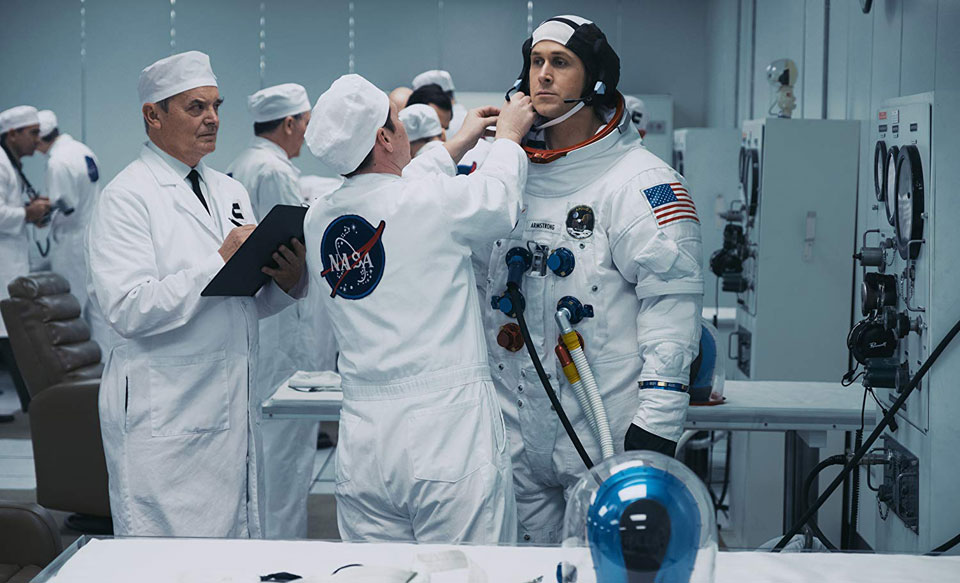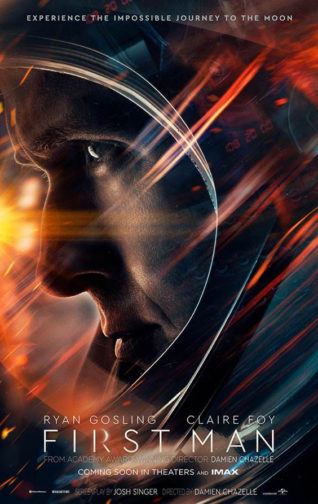
Director Damien Chazelle has had a meteoric rise in the Hollywood firmament. His 2014 hit Whiplash had a $3.3 million production budget and earned more than $13 million at the box office, while 2016’s La La Land cost $30 million. Presumably because that musical scored five times its costs, Chazelle’s latest movie, First Man, almost doubled La La Land’s budget. I usually don’t dwell on film finances and focus instead on cinematic esthetics, social commentary, film history and the like, but in the case of First Man the movie’s money matters have impacted upon its style, and in a mostly negative way.
The film’s title character is Neil Armstrong (Ryan Gosling), the first man to step foot on the moon. Like Miles Teller’s wannabe drummer in Whiplash and Emma Stone’s aspiring actress and Gosling’s striving jazz pianist in La La Land, First Man’s protagonist is—in this case, literally—reaching for the stars, against impossible odds.
In addition to being a biopic about this astronaut, First Man is also about the space race that pitted Washington against Moscow in the competition to scientifically dominate outer space—and in doing so, to have ideological hegemony down here on Planet Earth during the Cold War. Although this is not what First Man concentrates on, to its credit the movie depicts the U.S.-Soviet rivalry, as well as the New Left’s opposition to the expensive space program, contending that money spent on the space race could be better spent on social problems at home, such as reducing poverty. (The movie doesn’t go into the whole “Space Force” issue of militarizing the heavens, although the aeronautics industry is part and parcel of the military industrial complex. Can you say: “Wernher von Braun”?)
However, just as the Great Society’s programs suffered from spending taxpayer dollars on war as well as on the expensive space program (which President Johnson had helmed when he was JFK’s veep), costs limit the scope of First Man. One would imagine that the space race and the first manned moon mission would be a colossal cinematic extravaganza laden with special FX and the like, and would cost in excess of $100 million. But budgeted at a relatively modest (by Tinseltown standards) $59 million, First Man is more of mid-level movie than a top-tier production.
And the film suffers because of it. Much of First Man’s camerawork consists of close ups, when the subject matter requires many grandiose long shots on an epic scale. The first lunar mission should look something like Lawrence of Arabia set in outer space. Instead, much of the cinematography looks as if Chazelle is standing too close to you, invading your personal space, instead of illuminating outer space. It is too often tight when it needs to be titanic.
To be fair, Chazelle is in part trying to make a personal movie about Armstrong and his family, which includes his wife Janet (Claire Foy) and their children. Armstrong’s tragic loss is an important part of the movie and helps to explain why he is so taciturn and reticent: At a press conference the only term he can utter to express how he felt upon learning that he was chosen to head the first manned lunar landing is that he is “pleased.” He comes across as an emotionally stunted, driven man unable to tell his little boys he loves them before he blasts off into the wild blue yonder and beyond, and may never return to them. It doesn’t help that as an actor, Gosling has a limited range. Brando he’s not.
When the big screen opens up, parts of the movie are briefly spectacular. But the close-ups are often filler, repetitive and rather irritating in the huge IMAX format and I strongly suspect were shot in lieu of having the type of budget necessary for a movie about a mission of this cosmic caliber. It is as daft as Quentin Tarantino’s idiotically deploying the panoramic 70 mm widescreen format to show characters mostly in confined spaces—a stagecoach and cabin. Chazelle’s attempt to cinematically balance an indie-like character study with cinematic spectacle fails to launch. Thus much of First Man is ineptly directed and, like Ava Duvernay, who jumped from 2012’s indie Middle of Nowhere to 2014’s Selma, about the epic battle for civil rights, Chazelle is way over his head here.
First Man has drawn the ire of rightwing snowflakes, throwing temper tantrums over the fact that, like much of the moonwalk stuff, Armstrong is not shown planting the Stars and Stripes on the lunar surface. Never mind that Old Glory is glimpsed in some of the movie’s rare long shots: These crybabies are the worst politically correct fanatics in America, just as white nationalists are the worst examples of identity politics in the USA. They get their panties into a twist over any perceived slights to their sacred cows—their make-believe wrathful God, police and vigilante murderers of unarmed nonwhites, Pentagoon war criminals, sexual assaulters and, above all, symbols like the flag. These reactionaries may love America, but they despise Americans, and like those neo-Nazis in Charlottesville, wish the Union had lost the Civil War and the U.S. had lost World War II to their fascist soul mates.
Along with winning WWII, the space program was the only good thing Washington was able to accomplish on the international stage since the despicable nuking of Hiroshima (another hallowed totem of mindless conservatives we’re not supposed to, you know, like use our Constitutional right of free speech to criticize). The space race definitely had, as First Man reminds us, a propagandistic purpose, as the Russkies had beat us in space: From Sputnik to Laika, the first dog in orbit aboard 1957’s “Muttnik” to cosmonaut Yuri Gagarin, the first man in outer space in 1961, before John Glenn circled the Earth three times in 1962. Shortly after the truly miraculous Apollo 11 mission served its ideological agitprop purpose by beating the Soviets to the moon, proving once again the sheer lunacy of the capitalist class and its governmental minions who only pursue what they perceive to be in their immediate short-term self-interest, the manned lunar missions were abandoned.
Josh Singer, whose screen credits include the Pentagon Papers pic The Post (that completely downplayed Daniel Ellsberg’s role in exposing Washington’s Big Lies about Vietnam), Spotlight (about the Boston Globe’s exposé of clergy child abuse) and the WikiLeaks drama The Fifth Estate, adapted James R. Hansen’s 2005 book First Man: The Life of Neil A. Armstrong for this movie misfire. Corey Stoll’s (Rep. Peter Russo in the Netflix series House of Cards) depiction of Buzz Aldrin provides some comic relief and rehabilitated my opinion of the second man to walk on the moon. Around 2000 I had an unfortunate personal encounter with a loutish Aldrin who was—well, buzzed—and Stoll’s portrayal of him, in contrast to the emotionally constipated Armstrong, made me rethink the astronaut who is, after all, only human, with our flaws and triumphs.
But this droll performance isn’t enough to balance Chazelle’s aborted movie moon mission, which reads as if Stanley Kubrick had shot the optically opulent 1968 sci fi classic 2001: A Space Odyssey consisting mainly of close-ups of Keir Dullea, Gary Lockwood and HAL. In comparison to Kubrick’s sumptuous cinematography, Chazelle’s movie just looks cheap, even though Steven Spielberg, who is richer than God, exec produced this Dreamworks co-production. By the way, the image of a helmeted Gosling being used to advertise First Man walks that fine line between being a homage to or a rip-off of the far superior 2001. To paraphrase Jesus in Matthew 20:16, “the First Man shall be last.” First Man is the wrong stuff and Chazelle should stick to making low budget indies, his real filmic forte. But then, maybe he has gone La La Land.
The trailer can be viewed here. First Man opens wide across the universe on Oct. 12.










